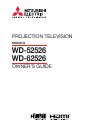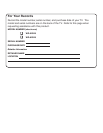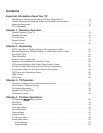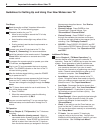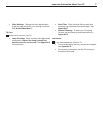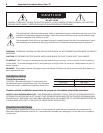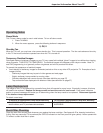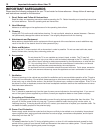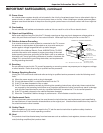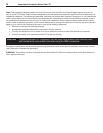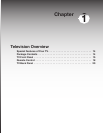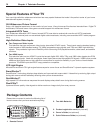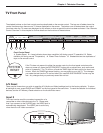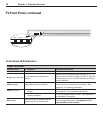
Important Information About Your TV 9
Lamp Replacement
The image on this TV is produced by a powerful lamp that will operate for many hours. Eventually, however, this lamp
will need to be replaced. Replace the lamp yourself and save the cost of a service call. Front-panel indicators
and/or on-screen messages will assist you in determining when the lamp needs to be replaced. Please see Appendix
F for details on lamp replacement.
To obtain a new lamp:
To Receive a Replacement Lamp Under Warranty To Purchase a Replacement Lamp After Warranty
Call (800) 332-2119. Please have model number,
serial number, and TV purchase date available.
Call (800) 553-7278. Order lamp part number
915P028010.
Dust-Filter Cleaning
Clean the dust filter annually and whenever you replace the lamp cartridge. See Appendix E for cleaning instructions.
A dirty filter may cause the TV to overheat (the STATUS indicator on the front panel will glow yellow). Never operate this
TV without a clean dust filter in place.
Operating Notes
Demo Mode
This TV has a demo mode for use in retail stores. To turn off demo mode:
1. Press TV MENU.
2. When the menu appears, press the following buttons in sequence:
0, QV, 0
Standby Fan
When the TV is off, you may hear a low-power standby fan. This is normal operation. The fan cools advanced circuitry
in this TV that must continue to operate even when the TV is turned off.
Temporary Residual Images
Prolonged display of stationary images on your TV may cause faint residual “ghost” images to be visible when viewing
other programs. THIS EFFECT IS TEMPORARY. The residual images will disappear within days or weeks. Most TV
and DVD programming is of generally uniform brightness and will not produce this effect.
To prevent the appearance of residual images:
• Avoid display of stationary images for extended periods on this or any other LCD projection TV. Examples of such
images include:
∙ Stationary images that may be part of video games and web pages
∙ Bright, stationary icons overlaid on moving video
∙ Side bars displayed with narrow-format video (see definition on page 37)
∙ Top and bottom bars displayed with letterbox video (see definition on page 37)



